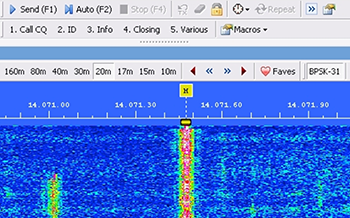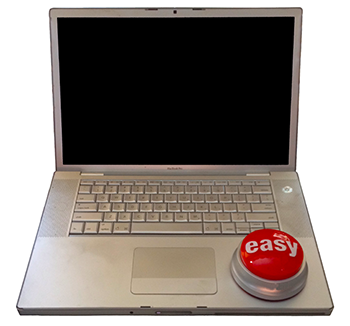[Note: This article was submitted to both slvarc.org and k6bj.org to cover a wider audience.]
 “Wow, now that’s cool! It reminds me of the movie ‘The Matrix’ with the colors and lines scrolling down the page”. I stood behind Frank (K6BDK) marveling at the fact that he was DXing with Hams around the world (even with his hearing impairment). Frank was showing a group of us how he keeps really active in the hobby by using HF Digital Radio.
“Wow, now that’s cool! It reminds me of the movie ‘The Matrix’ with the colors and lines scrolling down the page”. I stood behind Frank (K6BDK) marveling at the fact that he was DXing with Hams around the world (even with his hearing impairment). Frank was showing a group of us how he keeps really active in the hobby by using HF Digital Radio.
Frank then looked at me and said those important challenging words, “So, when are you going to go Digital?… It’s Easy.” I shook my head, knowing that this was the next step I needed to take, but fully aware that the learning curve could be steep: I’d be adding to the lumps of hard-earned knowledge on my noggin. Where to begin?
Well, I did the first thing I had previously found effective (some might think that picking up a book, getting online, or watching a video is a good approach): I immediately turned my sights to our local CAKE group (Coffee Assisted Knowledge Exchange). One Saturday morning I asked the loaded question, “Who knows about HF digital?” And then— this never surprises me—the discussion  around coffee blossomed into an interactive audio tutorial about what to look at, where to start, what resources there are, and strangely a lot of folks saying “It’s Easy.” Who was I to argue with this pileup of great free advice?
around coffee blossomed into an interactive audio tutorial about what to look at, where to start, what resources there are, and strangely a lot of folks saying “It’s Easy.” Who was I to argue with this pileup of great free advice?
Ever a slow learner, I jumped at the chance and asked if anyone would be willing to help me cut some corners and “get digital.” (I still think this was the smartest thing I did this month.) The person who had helped Frank also came to my aid: David (KG6IRW) said he would stop buy for an hour and see where I was in getting my radio on the air. So, prior to David’s arrival, I did a little reading (yes, it really helps), configuring, and preplanning.
My goal was to get two data modes working: RTTY (Radio Teletype) and PSK31 (Phase Shift-Keying). These appeared to be some of the most popular modes of digital operation (behind CW!). There are a number of free and paid tools available for both modes, and this article is intended to get you interested but not to evaluate them. Why should I take all the fun out of it?!
Previously I had set up computer control of my radio with proper cabling for both audio and serial port connection. This is really the trickiest part and is dependent on the radio you have. I would highly suggest that you review any on-line user groups for suggestions and directions. I found that setting up the free version of HRD (Ham Radio Deluxe) and using their information on radio control gave me the software tools, instructions, and information for my radio type necessary to get started.
Within a few minutes of his arrival, some really fast keystrokes, opening an HRD application called Digital Master (DM-780), and some quick configuration (which I followed and understood, and which is all documented, but would have taken me hours on my own), David was transmitting a few PSK test messages out to the world. How did we know it worked? Ah! It was how he showed me that was cool!
 PSKReporter is yet another cool software tool to allow you to see the beacon reports, information, and activity around the world. If you would like to know more about it, there is a good article on eHam.net at http://www.eham.net/articles/21157.
PSKReporter is yet another cool software tool to allow you to see the beacon reports, information, and activity around the world. If you would like to know more about it, there is a good article on eHam.net at http://www.eham.net/articles/21157.
About 15 minutes after sending the test messages, there I was on the map, being shown where other stations had seen my transmission. THANK YOU DAVID!!!
Mission accomplished? Not quite. The other driving desire about “going digital” was to fulfill my contesting fix. Yes, that was another underlying reason for going digital. I admit it. There has been a big push in the NCCC contesting community this year to add RTTY to your game. However, there was more to learn in interfacing all of the above to N1MM’s contest tracking software. I was one week away from an easy RTTY contest, but again found myself in a pickle on how to make it work. So, again I asked a simple question, “How do you get RTTY to work with N1MM”?
And I got the answer I was looking for… It’s Easy! Ok, maybe not in those words, but Bob (K6XX) said something to the effect, “I use the name Homer when I contest in RTTY, because it takes about a doughnut’s worth of effort once you get things set up right.” He then gave me the keys to the contesting kingdom by pointing me to videos and documentation located on the members-only part of the NCCC web site, as well as pointing out key NCCC mentors for RTTY. The videos are the boiled-down versions of what is documented the N1MM user manual and best contesting practices. NCCC videos really stepped me through the setup (with N1MM, WinTest, or WRITELOG software), presented contesting best practices, and, best of all, became a support group for aiding my addiction. That weekend I was up and running making Q’s—and yes, eating doughnuts and pounding function keys just like Homer. Doh!
So, was going digital easy? Not really, it takes time, effort, and learning, that usually doesn’t come easy.
So, was using digital easy? Yes, and fun too! Whether QRP or higher powers, it opens up radio communications.
So, was getting digital help easy? With some of the best operators, engineers, clubs, club members, and friends it was not only easy, but an enjoyable way to learn something new. I am indebted to all those who said It’s Easy, and then took the time to showed me how easy it was. If not for them I’d still be scratching my head and reading.
Here are my best references to get you started, and remember… It’s Easy!
- HRD (Ham Radio Deluxe) http://www.hrdsoftwarellc.com/downloads/default.html
- RTTY for Beginners: http://www.iw5edi.com/ham-radio/26/a-rtty-tutorial-for-beginners
- Getting Started with RTTY: http://www.aa5au.com/rtty.html
- MMTTY : http://www.aa5au.com/gettingstarted/rtty_downloadmmtty.htm
- PSKReporter: http://pskreporter.info/pskmap.html
- eHam.net PSKReporter review: http://www.eham.net/articles/21157
- NCCC : http://nccc.cc
Note: There is also a good article in the October 2012 QST about DX spotting networks.
Photo credits: Screenshots by Don K6GHA. Laptop with Easy button by Kerry K3RRY.